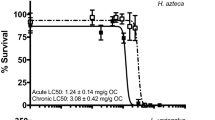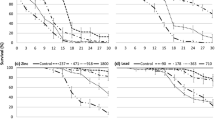Abstract
Chronic tributyltin toxicity experiments were conducted with the following Chesapeake Bay organisms: amphipod, Gammarus sp.; juvenile Atlantic menhaden, Brevoortia tyrannus and larval inland silverside, Menidia beryllina. TBT concentrations ranging from 29 to 579 ng L−1 did not significantly affect survival of the benthic amphipod, Gammarus sp. after 24-d exposures. The weight of Gammarus exposed to control conditions was 2.8 times greater than the weight of these test organisms exposed to 579 ng L−1 TBT. Twenty-eight day exposures to TBT concentrations of 93 and 490 ng L−1 did not significantly affect survival of juvenile B. tyrannus or larval M. beryllina. Histological examinations of B. tyrannus did not demonstrate absolute effects resulting from TBT exposure due to extensive variation between individuals. Various morphometric measurements of M. beryllina after TBT exposure did not demonstrate significant effects. However, significant reductions in growth were reported for M. beryllina at both TBT concentrations. Environmental concentrations of TBT in Chesapeake Bay and possible effects on the above biota are discussed.
Similar content being viewed by others
References
Alzieu, C.: 1986, ‘TBT Detrimental Effects on Oyster Culture in France — Evolution Since Antifouling Paint Regulation’, in Oceans 86 Proceedings Volume 4, Organotin Symposium, Washington DC, 1130—1134.
Batiuk, R.: 1987, Survey of Tributyltin and Dibutyltin Concentration at Selected Harbors in Chesapeake Bay — Final Report, Final Report, U.S. Environmental Protection Agency, Chesapeake Bay Liaison Office, Annapolis, MD, p. 58.
Bryan, G. W., Gibbs, P. E., Hummerstone, L. G., and Burt, G. R.: 1986, J. Mar. Biol. Assoc. U.K. 66, 611.
Hall, L. W., Jr., Bushong, S. J., Hall, W. S., and Johnson, W. E.: 1988, Environ. Tox. Chem. 7, 41.
Hall, L. W., Jr., Bushong, S. J., Johnson, W. E., and Hall, W. S.: 1987a, Spatial and Temporal Distribution of Butyltin Compounds in a Northern Chesapeake Bay Marina and Receiving System, Report, NAVSEA, Washington, DC, p. 30.
Hall, L. W., Jr., Lenkevich, M. J., Hall, W. S., Pinkney, A. E., and Bushong, S. J.: 1987b, Mar. Pollut. Bull. 18, 78.
Huggett, R. J., Unger, M. A., and Westbrook, D. J.: 1986, ‘Organotin Concentrations in Southern Chesapeake Bay’, in Oceans 86 Proceedings Volume 4, Organotin Symposium, Washington, DC, pp. 1262–1265.
Johansen, K. and Mohlenberg, F.: 1987, Ophelia 27, 137.
Laughlin, R. B., Nordlund, K., and Linden, O.: 1984, Marine Environm. Res. 12, 243.
Lawler, I. F. and Aldrich, J. C.: 1987, Mar. Poll. Bull. 18, 274.
Lee, R. F.: 1980, ‘Metabolism of Bis (Tributyltin) Oxide by Estuarine Animals’, in Oceans 86 Proceedings Volume 4, Organotin Symposium, Washington, DC., pp. 1182–1188.
Matthias, C. L., Bellama, J. M., Olson, G. J., and Brinckman, F. E.: 1986, Envir. Sci. Tech. 20, 609.
Newton, F., Thum, A., Davidson, B., Valkirs, A., and Seligman, P.: 1985, Effects on the Growth and Survival of Eggs and Embryos of the California Grunion (Leuresthes tennis) Exposed to Trace Levels of Tributyltin, Report 1040 Naval Oceans System Center, San Diego, CA, p. 15.
Sokal, R. R. and Rohlf, F. J.: 1981, Biometry, W. H. Freeman and Company, New York, NY, 776 pp.
Steele, R. G. D. and Torrie, J. H.: 1960, Principles and Procedures in Statistics, McGraw-Hill, New York, NY, 481 p.
Thain, J. E. and Waldock, M. H.: 1985, International Council for the Exploration of the Sea E, 28.
Valkirs, A., Davidson, B., and Seligman, P.: 1985, Sublethal Growth Effects and Mortality to Marine Bivalves and Fish From Long-Term Exposure to Tributyltin, Report, Naval Oceans Systems Center, San Diego, CA, p. 36.
Ward, G. S., Cramm, G. C., Parrish, P.R., Trachman, H. and Slesinger, A.: 1981, ‘Bioaccumulation and chronic toxicity of bis (tributyltin) oxide (TBTO): tests with a saltwater fish’, in D. R. Branson and K. L. Dickson (eds.), Aquatic Toxicology and Hazard Assessment, Philadelphia, PA, American Society for Testing and Materials, pp. 134–144.
Westbrook, D. J., Travelstead, E. J., Espourteille, F. A. Rice, C. D., and Huggett, R. J.: 1986, Tributyltin in Whole Water and Sediment Collected From Marinas and the Hampton Roads Area in the Southern Chesapeake Bay, Report, Virginia Institute of Marine Science, Gloucester Point, VA, p. 20.
Author information
Authors and Affiliations
Rights and permissions
About this article
Cite this article
Hall, L.W., Bushong, S.J., Ziegenfuss, M.C. et al. Chronic toxicity of tributyltin to Chesapeake bay biota. Water Air Soil Pollut 39, 365–376 (1988). https://doi.org/10.1007/BF00279481
Received:
Revised:
Issue Date:
DOI: https://doi.org/10.1007/BF00279481




